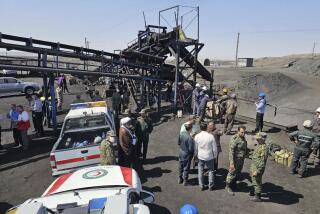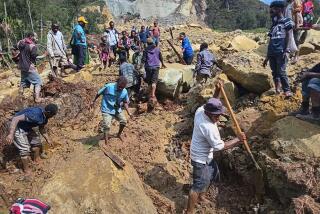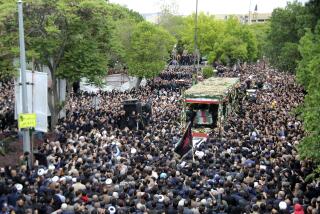Iranian Officials Reduce Earthquake Toll Figure
CAIRO — Rescue workers were running low on tents and blankets Sunday for the tens of thousands of Iranians left homeless after a powerful earthquake the day before damaged or leveled more than 100 villages in the mountains northwest of Tehran.
Yet even as workers dug with shovels and bare hands through mounds of dirt and splintered debris, desperately searching for survivors--or corpses--the government reduced by more than half the number of estimated casualties. On Saturday, the state said the quake had killed at least 500 people and left about 2,000 injured.
“The earthquake caused 227 deaths in the Qazvin region and three in Hamadan, and around 1,000 injured in total,” state television quoted a government statement as saying Sunday.
Still, there was some confusion about the figures. In the capital of Qazvin, the province where the quake’s epicenter was located, Gov. Jalaleddin Sharafi issued a statement saying that 500 burial permits had already been issued. In Zanjan province, northwest of Qazvin, an additional five bodies had been located, the state news service said--after the lower casualty estimates were released.
Whatever the final tallies, there seemed to be no end to the misery that enveloped community after community in a region known mostly for its vineyards and as a weekend getaway for wealthy residents of the capital.
In the oasis village of Changoureh, official reports said, only two of the village’s 100 houses were intact and the number of confirmed dead had reached about 120.
The government said it had pitched about 4,000 tents to care for the homeless and had gotten water and electricity service to most of the needy. But in some areas, survivors were forced to huddle around campfires in the frigid night air. In the hard-hit town of Avej, Reuters news service reported, 60 survivors threw stones at Interior Minister Abdul Vahed Musavi-Lari’s convoy as it passed through the area. They said the government had abandoned them.
“My child died, and the local people helped me to bring him out of the rubble. Only local people are helping,” said a man in the mountain town about 130 miles west of Tehran.
Frustration and anguish were widespread. State television showed image after image of parents crying over their dead children, young and old huddling in the grass and debris, shocked at the magnitude of their losses, both individual and collective.
Homes were gone. Families were gone. And so were whole communities.
“I don’t know whose house is whose. I don’t know whose belongings are whose belongings. My father. Oh, my father,” said Assad Mohammed, a Tehran resident, as he stood over a heap of tangled debris where his childhood home once stood in the village of Abdareh. His father, two sisters, a nephew, a niece and other relatives had all been crushed to death.
Abdareh was among the hardest-hit villages. About 45 families have lived there, and at least 20 bodies had been recovered by late Sunday. At a cemetery overlooking the village, dazed survivors huddled in groups. They sobbed as they placed their loved ones into fresh graves carved out by bulldozers.
“There is nothing left to live for,” cried Majid Torabi, 16, as he rested his head beside his parents’ graves.
The magnitude 6.3 earthquake struck at about 7:30 a.m. Saturday. It was felt across eight provinces, including in Tehran, where buildings swayed but no damage was reported. It left thousands homeless, mainly in the Qazvin provincial district of Bouynzahra, the epicenter, the official Islamic Republic News Agency reported.
The catastrophe was by all accounts inevitable. Iran is one of the most seismically active regions on Earth; beneath it, three tectonic plates meet, rub and collide. But a bigger problem is the way many rural houses are built. Timbers, brick and plaster are all that is used. The construction is so primitive, so fragile, that houses have been known to cave in after the faint tremors that rock Iran almost daily.
“The mud brick houses turn into dust,” said Morteza Shahbodaghi, a Red Crescent Society relief worker in the quake area. “They are neither sturdy nor allow for easy rescue.”
The casualty rate might well have been higher, but Saturday is the first day of the workweek for many in Iran, and a number of men had already gone out to tend their grapes and fruit orchards.
In the hours immediately after the quake, the government and Red Crescent said that the death toll had hit 500 and that the number was expected to rise. On Sunday, Iran’s morning newspapers reported the number of dead at more than 500. The newspaper Hamshahri quoted an anonymous official in the Bouynzahra governor’s office saying that there were still 150 bodies to be recovered in the villages of Changoureh and Abdareh alone, and that 200 people had died in Changoureh.
But as condolences began to pour in from around the world, and as Germany and Kuwait offered cash to help with rescue and recovery efforts, the state news service issued its updated figures. It quoted a Red Crescent official as saying only that the initial figure was wrong.
Officials did not, however, lower their estimate of 5,000 houses flattened, and if anything, with at least 21 aftershocks having rolled through the region, that figure was expected to climb. Meanwhile, at least 25,000 people were reported to be homeless over a wide rural area, and the state news service quoted an official in Bouynzahra as saying that aid workers were running short of tents.
The Iranian government, particularly the conservative religious leadership, is often loath to accept aid from Western countries, particularly the U.S., which it still calls “the great Satan.” But in this case, it appeared ready to set aside animosities, if only temporarily, to get food and shelter to the people.
Asked if Tehran would accept an offer of assistance that Washington made, Musavi-Lari, the interior minister, told Reuters, “We are ready to accept all aid from NGOs,” or nongovernmental organizations.
Musavi-Lari toured the village of Qanuraeh on Sunday and expressed the government’s condolences.
“Our job was to recover the bodies, but from today we have to think of reconstruction during the summer, before it gets cold in the winter,” he said.
The government also, it seems, was willing to confront another taboo--dogs. Because Islamic teaching says that dogs are unclean, authorities have been reluctant to use dogs to locate victims trapped under the rubble. Twelve years ago, after a major earthquake, officials refused to use dogs. This time, witnesses said, they were using German shepherds.
An eyewitness said that one village was flooded with hundreds of ambulances and large numbers of soldiers but that villagers had asked for additional dogs, saying they would be more useful.
Haleh Anvari in Tehran and Borzou Daragahi in Abdareh contributed to this report.
More to Read
Sign up for Essential California
The most important California stories and recommendations in your inbox every morning.
You may occasionally receive promotional content from the Los Angeles Times.










